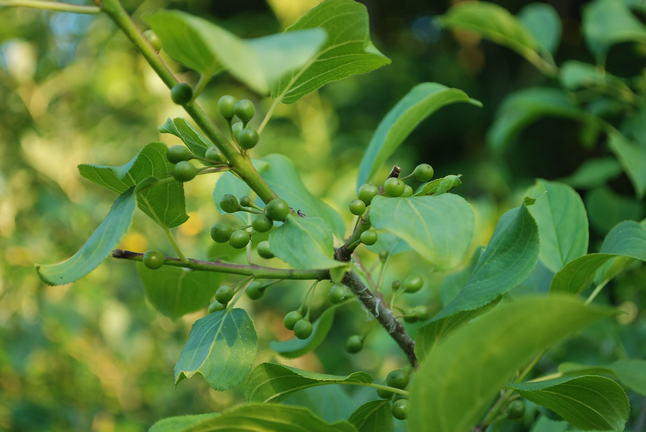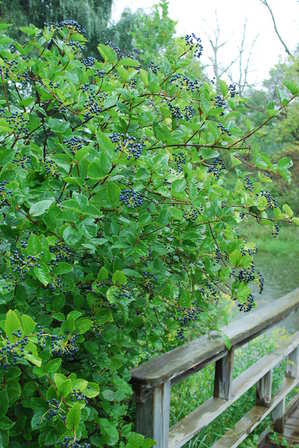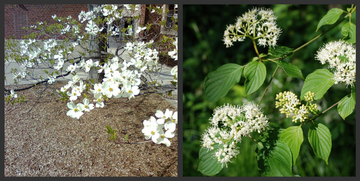Making a difference in your yard - swap out invasive common buckthorn and try a native plant instead

Common buckthorn (Rhamnus cathartica) berries are green now, but soon they'll be black and ready to pass rapidly through the digestive system of birds near you!
Rick Meader | Contributor
In any case, if you want to do something relatively simple in your yard that will help birds and make your yard a bit prettier, I have a suggestion for you. Trade out all of your buckthorns for a native, fruit-bearing shrub.
As I observe many, many yards, I am struck by how many are lined with, or at least have a few, buckthorns at their edge, probably Common Buckthorn (Rhamnus cathartica). It’s certain that those buckthorns were not planted deliberately.
They came via the very birds you’d like to help. They ate some berries from another buckthorn and shortly thereafter sat on your fence or in the tree above where the grown buckthorn is now and felt the after-effects of the berries cathartic (belly-rumbling) qualities, and deposited a fertile seed in your yard.
Soon after that, the tree slowly began to grow, an innocuous oval shaped deep green-leaved seedling, then a sapling, and not too much later (perhaps as little as a few years, depending on the sun it gets), a fruit-bearing small tree. As it was on the edge of your yard, or in a remote place, you may not have even noticed it, but its impact on its environment had begun. According to research, and observation, here are some of the effects you might be experiencing:
Shading out ground that previously supported wildflowers in the spring Have you noticed that they aren’t as plentiful in your yard as they once were? Shade is not the friend of spring ephemerals — they grow and bloom quickly, before the shade of the native tree species above them leaf out. They may be found in a shady forest, but they do their real work in the early spring, when they woods aren’t shady. Buckthorns leaf out well before native trees, creating unnatural, early shade in the woods, preventing the native wildflowers from getting the sun energy they need to grow and bloom.
Changing growing conditions of young trees in the woods where you find them. Along with shading out wildflowers, they also shade out young oaks and hickories in those woods. If you go in a buckthorn-infested woods, you’ll see very few small oak seedlings. There isn’t enough sun for them.
Changing soil conditions. Research has shown that buckthorns actually change the chemical makeup of the ground where they grow, particularly the soil moisture and pH. This can make the ground more suitable for new buckthorns and other weeds and less suitable for some native species to grow, particularly those that compete better in drier, poorer, more acidic soils.
Crowding out native species. Buckthorns spread quickly with very fertile seeds, crowding out native shrubs or small trees that might otherwise be found in the habitat where the buckthorn grows. Understory trees and shrubs like dogwoods (Cornus spp.), Ironwood (Ostrya virginiana), Musclewood (Carpinus caroliniana), Prickly Gooseberry (Ribes cynosbati) and Serviceberry (Amelanchier spp.) to name a few, might not be able to get started or have a significant presence in woods that are crowded with buckthorn.
Harming amphibians. This one I just heard about. Apparently, buckthorns exude a chemical called emodin that is toxic to amphibians. As you may know, amphibians are decreasing in number for a variety of reasons, and if you can do something to help out Kermit and his amphibious friends, that would be a nice thing to do.

Viburnum berries are great food for birds, and don't add harmful invasive plants to the environment.
Rick Meader | Contributor
So, what can you do? You can have an incremental difference in the world around you by removing every buckthorn tree or sapling on your property, and planting at least one new native fruit-bearing shrub to replace those nasty buckthorns. You don’t have to replace on a one individual for one individual basis, just a 1:1 replacement by species.
By removing all of your buckthorn, and keeping after them to make sure they don’t come back, you’ll improve the habitat on your yard and reduce the negative effect on natural areas and others’ yards by removing the source of seeds that have been coming from your buckthorns.
Then, plant at least one individual of fruit-bearing native viburnums (V. acerifolium, V. dentatum, V. lentago, V. prunifolium and V. rafinisquianum are all native to Michigan), dogwoods (Cornus alternifolia, C. amomum, C. florida, C. foemina (racemosa), C. rugosa and C. sericea (stolonifera) are all native to Michigan or Serviceberry (Amelanchier arborea and A. laevis are both native to Michigan) in your yard. This native replacement will still provide a food source for birds and will add beauty to your yard when it flowers that buckthorns do not.

Flowering Dogwood (Cornus florida) and Alternate-leaved Dogwood (Cornus alternifolia) are both beautiful, fruit-bearing native small trees that would be great trade bait for Common buckthorn.
Rick Meader | Contributor
To make your impact even greater, tell your friends about the 1:1 trade and encourage them to barter in their own yards. Sometimes in this world it can get frustrating to see how much we can’t change, but this is an area where, with a handsaw and a shovel, you can make a world of difference, in your part of the world. I hope you’ll do it soon.
This week, in our ever-growing arboretum of a one-quarter acre sunny lot, we have blooming Hairy Beardtongue, Foxglove Beardtongue, Black-eyed Susan and New Jersey Tea. The one Sand Coreopsis bloom we had for a short time is going to seed. Get out in nature and enjoy the long days everyone!
(We’ll get back to imagining your yard in the next entry).
Rick Meader is a local landscape architect whose firm, Ecological Edge LLC, specializes in creating designs for homes, businesses and even churches that include a lot of native plants (and the wildlife they attract). You can contact him at ecologicaledgellc@yahoo.com.


Comments
Susan
Mon, Jul 8, 2013 : 3:06 a.m.
Wonderful article. When I lived in Ann Arbor (now live north of Chelsea) my back neighbors had buckthorn trees that I am sure they didn't even know what they were. I used to cut as much of them off as I could without going into their yard, Where I live now on 10 acres, we are slowly removing as many invasives as we can: especially buckthorn, Autumn Olive and Multiflora Rose and of course, our friend, garlic mustard. And yes, as you say, planting more natives. Interestingly natives start growing too once you get rid of the bad guys. Where we removed a small forest of Autumn Olive last fall, now I see a bunch of Sassafras seedlings.
Jackie Byars
Fri, Jun 28, 2013 : 3:34 p.m.
I love dogwoods and have both varieties you recommend (plus a lovely volunteer gray dogwood). I also highly recommend serviceberry. They have beautiful white flowers for a while in the spring and develop berries that birds LOVE. And they turn a spectacular red in the fall.
Rork Kuick
Fri, Jun 28, 2013 : 6:27 p.m.
Serviceberry seems to be having a bumper crop this year (also true of many other plants). I've caught people picking buckets of them recently. "for a while" made me laugh - yeah, we wish it was longer.
Rork Kuick
Fri, Jun 28, 2013 : 2:07 p.m.
In some neighborhoods in Ann Arbor I see common buckthorn has overtaken hedges that were originally other plants, like roses. They are often trimmed neatly by hired help who have no idea what the plants are. The buckthorn wins. My Pale-spike lobelia (Lobelia spicata) are on. It's my new experiment to see if they are good looking and easy to grow in normal gardens. It's from a volunteer in my yard (I failed to mow some places for a while after the tornado last year). I see some fancy plant places sell it or it's seeds. Several subspecies though, with varying flower color, that I am not yet expert at. I see mostly pale-blue around here, but some almost white. Pretty much sun and pretty wet places in the wild, and might get too tall without enough sun. For those with cardinal flower and great lobelia, this could be the way to make it a trifecta. The flowers are much smaller than great lobelia, but there are very many on each spike. They bloom for a long time it seems (this year).